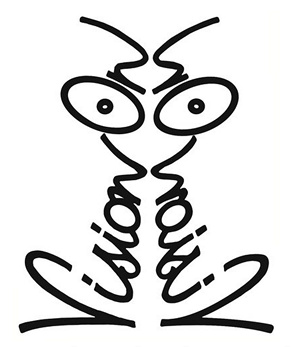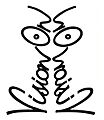Vision On facts for kids
Quick facts for kids Vision On |
|
|---|---|
 |
|
| Created by | Ursula Eason and Patrick Dowling |
| Developed by | Ursula Eason and Patrick Dowling |
| Directed by | Patrick Dowling, Gerald Wiltshire, Diana Potter, Michael Grafton-Robinson, Peter Wiltshire, Clive Doig |
| Presented by | Pat Keysell and Tony Hart |
| Starring | David Cleveland, Ben Benison, Wilf Lunn, Sylvester McCoy |
| Opening theme | "Accroche-Toi, Caroline" by Caravelli |
| Ending theme | "Java" by Al Hirt and Bert Kaempfert |
| Country of origin | United Kingdom |
| Original language(s) | English and British Sign Language |
| No. of seasons | 15 |
| No. of episodes | 168 |
| Production | |
| Producer(s) | Patrick Dowling |
| Production company(s) | BBC |
| Distributor | BBC |
| Release | |
| Original network | BBC 1 |
| Original release | 6 March 1964 – 11 May 1976 |
| Chronology | |
| Preceded by | For Deaf Children |
| Followed by | Take Hart |
| Related shows | Hartbeat |
Vision On was a popular British television show for children. It was shown on BBC1 from 1964 to 1976. The show was made especially for children who had hearing difficulties. It used lots of visual elements and British Sign Language to make it easy to follow without sound.
Contents
Meet the Presenters
Vision On had a great team of presenters who made the show special. Here are some of the main people you would see:
- Pat Keysell: She was an actress and also taught deaf children. She helped present the show.
- Tony Hart: A famous artist who created amazing pictures. He used many different sizes and materials. Tony also encouraged children to send in their own artwork for "The Gallery." Thousands of kids sent in their drawings!
- Ben Benison and Sylvester McCoy: These two were mime artists. They used body language and actions to tell stories without words.
- Wilf Lunn: He was an inventor who created funny and unusual machines.
- David Cleveland: He often appeared in short films as a character called "The Prof."
Fun Parts of the Show
Besides the artwork and presenters, Vision On had many memorable parts. These segments were often visual and didn't need much sound.
The Gallery
This was a very popular part of the show. It showed artwork sent in by viewers. The name and age of the young artist were displayed with their picture. Sometimes, the artwork matched the theme of that week's show. At the end, Pat Keysell would thank everyone. She would also say that there was a "prize for any that we show."
The Burbles
The Burbles were two unseen characters who lived inside a grandfather clock. They talked using speech bubbles that appeared on screen. They often told funny jokes or puns. Sometimes, their voices sounded like they were underwater.
The Prof
"The Prof" was a character played by David Cleveland and other filmmakers. He wore a white lab coat and usually did funny things outdoors. His actions were often silly and visual.
Humphrey the Tortoise
Humphrey was a tortoise who would talk about specific things, often a pun or a joke. His speech, and anyone he talked to, was shown on screen as text. There was no audio for his voice.
The Digger
"The Digger" was a "cut-out" cartoon man. He was designed and animated by Bill Mather and George Dunning. Each week, he would dig into the dirt on a construction site. He always found something interesting.
The Animated Clock
This segment featured an animated cuckoo clock. Sometimes, the clock would have problems. Other times, its parts would come to life like people. A small animated man would also wander around a surreal world and interact with the clock's bird.
The Woofumpuss
In later episodes, there was a running gag with a fuzzy worm called "The Woofumpuss." One of the cast members would frantically chase it. They would try to catch it but never could. Sometimes, it would even mess up the artwork by Tony Hart and Pat Keysell!
Aardman Animations
This part of the show featured clay animation. It was created by Peter Lord and David Sproxton. They made characters like the Greeblies. These characters were early versions of their later famous creation, Morph. They also created a superhero called Aard-man. Lord and Sproxton later named their company, Aardman Animations, after this character.
Music in the Show
Even though the show was for children with hearing loss, it used a lot of music. This was for the benefit of viewers who could hear.
- The opening song was "Accroche-Toi, Caroline" by Caravelli.
- The closing song was "Java" by Al Hirt and Bert Kaempfert.
- For "The Gallery" section, the music was "Left Bank Two" by Wayne Hill. This song became very well-known.
- "The Burbles" had a theme song called "Goofy" by Cliff Johns.
- "Humphrey the Tortoise" used "Merry Ocarina" by Pierre Arvay.
- "The Animated Clock" scenes used "Gurney Slade" by Max Harris and "Keystone Capers" by Eric Peters.
- "The Digger" music was "Elephant Dance" by Harry Pitch.
- "The Prof" often used "Comedy Cocktails 2" and "Comedy Cocktails 4" by Paul Gerard.
Where it Was Shown
Vision On was popular in many countries around the world. It was shown in places like Australia, Canada, France, Germany, and New Zealand.
In the United States, many PBS stations showed Vision On in the 1970s and 1980s. Some stations even made their own versions of the episodes.
Series Information
Vision On ran for 15 series (seasons) and had 168 episodes in total. It started on March 6, 1964, and the last episode aired on May 11, 1976.
- Series 1: 29 episodes (1964–1965)
- Series 2: 6 episodes (1966)
- Series 3: 6 episodes (1966)
- Series 4: 7 episodes (1967)
- Series 5: 6 episodes (1967)
- Series 6: 12 episodes (1967–1968)
- Series 7: 11 episodes (1969)
- Series 8: 9 episodes (1970)
- Series 9: 9 episodes (1970)
- Series 10A: 9 episodes (1971)
- Series 10B (Best of): 6 episodes (1971)
- Series 11: 16 episodes (1971–1972)
- Series 12: 16 episodes (1972–1973)
- Series 13: 16 episodes (1974)
- Series 13 (again): 16 episodes (1974–1975)
- Series 14: 14 episodes (1976)
Lost Episodes
Sadly, over 70 episodes of Vision On are either lost or have most of their footage missing. However, all episodes from Series 9 onwards are still available.
Images for kids
See also
 In Spanish: Vision On para niños
In Spanish: Vision On para niños


